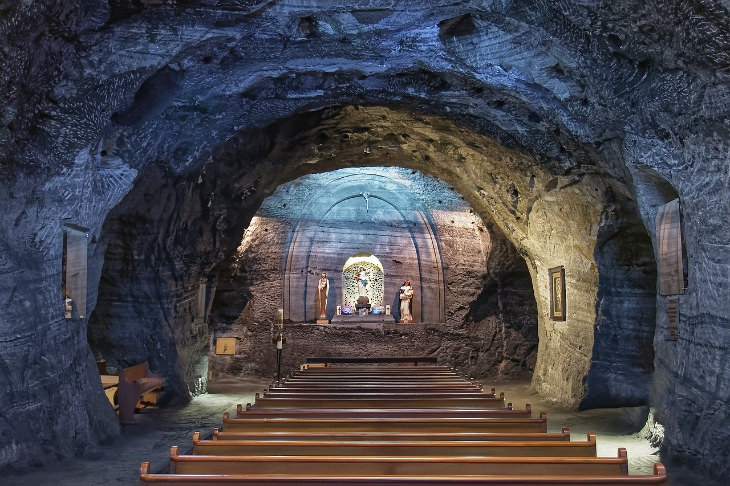Zipaquira Salt Mine
Inside this salt mine in Colombia, there's the Salt Cathedral. Nearly 600 feet (183 meters) beneath the ground, this cathedral is carved into the ground, complete with a baptismal font and a crucifix. The natural structure of this cathedral provides the proper divine acoustics. 14 little chapels are leading up to the cathedral, representing the Stations of the Cross. The first chapel was carved by the miners in 1954, while the mine was still operating. Due to safety concerns, it was shut down in 1990 and re-opened as a Christian site in 1995.
Rammelsberg Mines
This mine in Germany is the first-ever documented site of mining activity. It started operating as early as the 10th century. Underground water flooding the mine shafts quickly became a common problem. Around the 1250s, waterwheels were used to wheel out the water. They also functioned as an energy source. In 1572, a drainage passage was carved for efficient water flow. It was 7,710 feet (2,350 meters) long. The mine stopped operating completely in 1988. Over the centuries it yielded silver, copper, lead, gold, and zinc, making the town a culturally rich center. Now it operates as a museum.
Zollverein Coal Mine
This coal mine in Germany started operating in 1847. For a long period of time, it was the largest operating coal mine in Europe, supplying coal to the local iron and steel industries, but it finally shut down in 1986. During the 1920s, in an attempt to increase productivity, the A-shaped frame was installed and some new buildings were built around the mine, such as a coal washing department. Nowadays, modern businesses operate from those buildings. The coal washing building functions as a museum, and the old boiler-room building is home to a design center.
Wieliczka Salt Mines
Mining work in this salt mine in Poland started from the 13th century and went on continuously until 1992. Incredible! This mine has nine levels and it is 1,072 feet (327 meters) deep. There are small chapels with salt statues that were all carved by miners, including a few small lakes. The oldest chapel is the Baroque St. Anthony Chapel where mass was first celebrated in 1698. Everything in this chapel is carved from rock salt, including the chandelier made with salt crystals.
Big Hole
In 1871, a local from South Africa found an 83-carat raw diamond on a hill. The discovery drew many people to the area, and a town by the name New Rush was formed. During the colonialism period, the name was changed to Kimberly, the hill vanished with diggings, and today we are left with what's called the Big Hole- the richest diamond mine in South Africa. It is 700 feet (215 meters), deep, almost 1 mile (1.6 km) wide, and it yielded close to 3 tons (2,700 kg) of diamonds before it was closed in 1914. Thanks to its riches, Kimberly was the first town in the Southern Hemisphere to have street lights, in 1882.
Las Médulas
This rocky terrain in Spain used to be the Roman empire's biggest gold mine. During the first and second centuries, they extracted about 800 tons of gold, using a typically brilliant Roman hydraulic system. The site was finally left during the second century and it remained untouched, giving us, present-day visitors, a glimpse into the past. Today visitors can hike and see the man-made caves where the gold was mined.
Great Copper Mountain
According to the Swedish legend, this copper mine was discovered thanks to a goat! As legend has it, the farmer noticed that his goat came back from the pasture with red horns. They were dyed by the copper in the mine. We'll never know how true this story is, but we can tell you for sure this mine started operating as early as the 9th century in Sweden, and by the 17th century it was responsible for a third of all the copper in the world. But in 1687, the mine collapsed. There were no casualties as everyone was away on holiday. This didn't stop the mine working though. It went on, uninterrupted, from the 9th century until 1992.
Dinorwic Slate Quarries
Relative to the other mines on the list, this slate mine in Wales is relatively young! It started operating in 1787, exporting its goods at first by a horse-drawn tramway, and then by a narrow railway. 3000 men were working on the mining site by the end of the 19th century, but the mine shut down in 1969 to become a museum.

